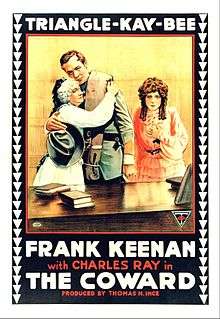Kay-Bee Pictures
Kay-Bee Pictures was a film company. Its executives included Thomas Ince. The company's mottos included "Every picture a headliner" and "Kay-Bee stands for Kessel and Baumann and Kessel and Baumann stands for quality", referring to Adam Kessel and Charles Baumann.[1] It was party of the New York Motion Picture Company and was used after a settlement with rival Universal Pictures to end the film division named 101 Bison.[2] Anna Little was one of its stars.[3]

Poster for The Coward
_-_Ad_1.jpg)
Ad for The Redskin Duel, a rerelease of The Death Mask (1914)
Filmography
- The Paymaster's Son (1913)
- The Sergeant's Secret (1913)
- Love's Sacrifice (1914)
- Mother of the Shadows (1914)
- The Death Mask (1914)
- The Geisha (1914)
- The Golden Claw (1915)
- The Winged Idol (1915)
- The Coward (1915)
- The Famine (1915)
- The Beckoning Flame (1915)
- Civilization's Child (1916)
- Somewhere in France (1916)
- Hell's Hinges (1916)
- The Return of Draw Egan (1916)
- The Three Musketeers (1916)
- The Stepping Stone (1916)
- The Wolf Woman (1916)
- The Corner (1916)
- The Apostle of Vengeance (1916)
- The Weaker Sex (1917)
- The Clodhopper (1917)
- The Hater of Men (1917)
- The Bride of Hate (1917)
- The Millionaire Vagrant (1917)
- The Gunfighter (1917)
- Happiness (1917)
gollark: But I need multiple bismuths and a stellated dodecahedron.
gollark: Bismuth is inherently necessary.
gollark: I disagree. I need :bismuth:.
gollark: For example: \🐝.
gollark: Unicode, however.
References
- "Motion Picture News". Motion Picture News Incorporated. December 21, 1912 – via Google Books.
- Tasker, Yvonne (August 19, 2004). "The Action and Adventure Cinema". Routledge – via Google Books.
- "To-day's Cinema News and Property Gazette". Amer. Company, Limited. December 21, 1913 – via Google Books.
This article is issued from Wikipedia. The text is licensed under Creative Commons - Attribution - Sharealike. Additional terms may apply for the media files.